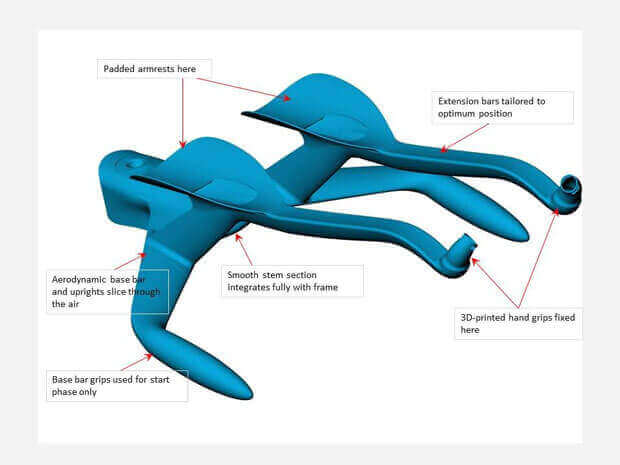Last Sunday Sir Bradley Wiggins rode his bike into the record books, when he covered 218 laps of the London Olympic Games track to push the world one-hour distance to 54.526 km. And he did it using 3D printed handlebars.
Made from titanium, the ultralight, aerodynamic handlebars were 3D printed at the University of Sheffield’s Mercury Centre. The use of additive layer manufacturing gave Wiggins and his team a key advantage, thanks to the ability to produce bespoke designs that could be adjusted and refined right up until the final practice stages of the event.
Wiggins broke the record for the furthest distance a cyclist can ride within an hour, an incredible 54.526 kilometres, which amounts to 218 laps of the London Olympic Games track. The 2012 Tour de France winner and London 2012 gold medallist smashed the previous record of 52.937km held by fellow Briton Alex Dowsett, who set the benchmark only five weeks previously.
Pinarello Lab are the makers of the bike on which Wiggins cruised to glory. Although the main frame of the bike – a Pinarello Bolide HR – is made from carbon fibre (providing the ideal combination of strength and weight), it was also necessary to produce handlebars that were perfectly adapted to Sir Bradley’s body measurements and cycling style. The challenge was to make and test a succession of prototypes in a small window of time, something which isn’t easy to do with carbon fibre.
Managing Airflow with 3D Printed Handlebars

For a solution, Pinarello Lab turned to Sheffield’s Mercury Centre, a research institute within the Faculty of Engineering that had just the right experience for this record attempt. The research group at the Centre has specialised in world-leading scientific research on 3D printing and other technologies since 2007, and worked closely with Formula 1 racing teams and aerospace companies in the past.
“The key is to manage the airflow around the bike so the different components of the bike disrupt that flow as little as possible,”says James Hunt, research associate at the Mercury Centre. “Because the handlebars hit the airflow first it’s absolutely critical to perfect that part of the design – 3D printing allows us to make shapes that optimise this aspect that would be very hard to achieve using other manufacturing techniques.”
The 3D printed handlebars were created using an Arcam Electron Beam Additive Manufacturing machine. In short order, the designers were able to refine the design without the necessity of creating new moulds to form each piece, leaving enough time to comprehensively test and adjust parts before the record attempt.
Dimitris Katsanis, chief designer in Pinarello Lab, is justifiably proud of Wiggins’ achievement. “Bolide HR is the most aerodynamic bike in the world,” he says. “When it came to the handlebars, we needed them to be as good in terms of aerodynamics, but we also needed them to be a perfect fit for the rider.”
Bending the Rules?
However, in subsequent days after the record was broken, dark clouds loomed over Sir Bradley’s achievement. Alex Dowsett’s coach Steve Collins told BBC Essex he thought that the bike and bars ridden by Wiggins were not within current regulations.
“One of the sad bits about it was that Bradley’s bike wasn’t in production,” Collins said. “For attempts like that it should all be production available so you can buy it off the shelf. You can’t get 3D-printed handlebars moulded to your own arms to make it easier for your own attempt.”
But the Wiggins camp were quick to pour cold water on these claims. “We had to do full documentation for the UCI detailing every component; every bit of the bike and kit was approved by the UCI down to the shoes, helmet and skinsuit. The bike is fully approved by the UCI,” a source close to Wiggins told The Guardian newspaper.
“The handlebars are made under a new manufacturing process, but Pinarello are offering this commercially through their MOST brand. It was the first time this had been done at this level, but a full mountain bike frame was made in this way last year, and parts for bikes have been made in this way in America, the US and Australia.”
Image source: Mercury Centre
License: The text of "3D Printed Handlebars Help Set World Record" by All3DP is licensed under a Creative Commons Attribution 4.0 International License.